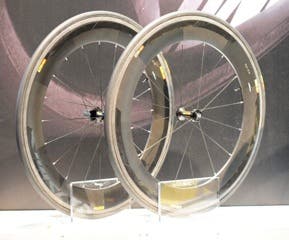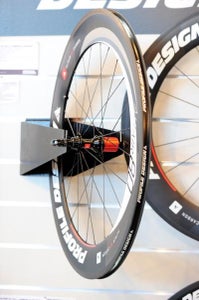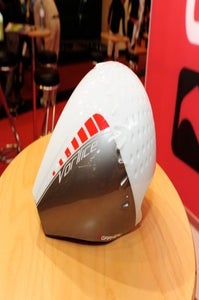Revolution: Race Wheels Take A Leap Forward

The experts agree: wheels are the most important component on a triathlon bike. They have a tremendous impact on a bike’s weight, ride quality and—most importantly—their aerodynamics. Many specific wheel innovations and general trends were on display at Eurobike and, after talking to wheel designers, engineers and brand mangers, Aaron Hersh recaps the technological advances that were on display. Read Hersh’s thoughts on the advancement in race wheels, then scroll down to see a photo gallery of the new wheels.Written by: Aaron Hersh
Zipp and Hed dominated the aero wheel market for nearly two decades because they had the most aerodynamic rims. Most of their advantage was due to the toroidal rim shape that was protected by a patent shared by the two companies. This shape—widest at the middle of the rim, similar to a football—was shown time and again to be the fastest design on the market. The patent on the toroidal rim expired this year and two companies have finally jumped on the opportunity to close the gap to Zipp and Hed.
Mavic CC80

The Mavic CC80 rim shape is quite similar to Hed’s previous-generation Stinger 9, and I mean that as a compliment. The CC80’s have a 23mm wide brake track and the rim flairs out slightly at the waist before tapering back in towards the bottom of the rim. It forms a relatively blunt but still rounded edge where the rim meets the spokes. This design allows the tire to integrate smoothly into the rim, which turns the wheel into a single continuous aerodynamically sound shape. Wind tunnel data has not yet been published, but the French company clearly did their homework when designing this wheel and I eagerly anticipate hard information about this wheel’s efficiency. It weighs 2,330 grams with tires and will be available in January, 2011.
Reynolds RZR 92.2
The RZR 92.2 is the other new aero wheel that has taken design queues from the formerly-patented toroidal rim design. The 92.2 has a very wide brake track—27mm, equal to Zipp and Hed’s 2011 wheels—that allows the tire to sit within the walls and create a smooth, continuous unit from both the tire and the rim. The rim walls are horizontal just beneath the tire and they taper dramatically into a razor-sharp edge where the rim meets the spokes.
The all-carbon spokes are designed with a NACA airfoil profile (similar to a Cervelo downtube) to further reduce drag. Traditional wheels with metal spokes draw their strength from tension on the spokes, but Reynolds leaves these carbon spokes un-tensioned. They say that carbon spokes have a tendency to buckle under tension and that this design is more durable and reliable than a wheel with tensioned carbon spokes. In the event that they do break, Reynolds can replace broken spokes at their Utah-based facility.
The rim is exactly 92.2mm deep, which begs the question, “why not 92?” Designer Paul Lew says that the ratio between rim width and depth is an absolutely critical part of aerodynamic design and he found that this exact ratio creates less drag than a 92mm rim or a 93mm rim.
The wheels weigh in at 1,400 grams, about 100 grams lighter than the 2011 Zipp 808s, and the RZR 92.2’s cost an incredible $6,000. These aren’t exactly a product for the everyman, but their unique rim shape and feather-light weight make them a fascinating wheel, even if they are well beyond the budget.
Wide wheels
Until 2007, every aero wheel had a 19mm wide brake track, which is the standard width of road training wheels. The problem with this design is that most tires are 23mm wide. This differential between tire width and rim width allows the tire to protrude out over the sides of the rim, which creates drag. Even if a rim has an aerodynamically efficient shape but a narrow brake track, the bulging tire slows it down.
Hed pioneered wide rim wheels back in 2007 to prevent the tire from sticking out beyond the rim and the design is so effective that they and Zipp—the two most aerodynamically advanced wheel manufacturers—now only make wide-rim aero wheels. The rest of the wheel manufacturers have now followed that trend. Instead of releasing more 19mm wide rims, many of the other players in the wheel market are making 21mm wide wheels in 2011.

The American Classic Carbon 85 is built with their own proprietary rim that features, you guessed it, a 21mm wide brake track.
Stalwart triathlon brand Profile Design unveiled their Altair line of wheels—including 52mm and 80mm deep rims that are offered as carbon clincher, tubular or aluminum clincher options—which also has a 21mm wide brake track.
Xentis’ Squad 5.8 tubular wheels, although not brand new, are also built with wide, 22mm rims.
The wide rim might separate these straight-walled aero wheels from the pack. The wheel industry has wisely adopted some design features from Zipp and Hed, but the two leaders have not rested on their accomplishments. They both introduced newly redesigned wheel lines that have once again lifted the bar.
Hed Stingers
Hed Stingers, their line of carbon rim tubular wheels, are designed around a massive 28mm wide brake track. This humongous rim dwarfs the tire and turns the entire tire-wheel unit into a wide, toroidally bulged rim. The tire does not protrude out beyond the rim whatsoever. Hed uses this same design philosophy for their entire Stinger line,

which includes the 40mm deep Stinger 4 (26mm wide rim), the 60mm Stinger 6 and the 90mm Stinger 9.
The Stinger 9’s were featured in the recent VeloNews aero wheel test conducted in the A2 Wind Tunnel and they blew every other wheel away. This test was particularly convincing because it was funded by an impartial magazine rather than by a manufacturer with a stake in the results.
Zipp Firecrest

Zipp and Hed designed their 2011 wheel lines simultaneously and they ended up with remarkably similar designs. The Firecrest rim shape is 27mm wide at the brake track and its widest point is about 65% toward the spokes, away from the rim. Zipp engineer Michael Hall says this shape reduces the drag created by the trailing half of the wheel, but the foundation of the Firecrest wheels is, once again, a very wide rim that tucks the tire into the rim.
The Hed Stingers are only available as tubulars but Zipp is offering their ultra-wide Firecrest rim design in both clincher and tubular forms at 404 and 808 rim depths. Four wheels in total. Hall says the clinchers and tubulars present exactly the same shape to the wind and have nearly identical drag characteristics.
Wheel manufacturers are making real progress, but Zipp and Hed seem to be, once again, one step ahead of everyone else.
Road Tubeless Clinchers
Mountain bikers have enjoyed the benefits of tubeless clincher tires—fewer flats, low rolling resistance, smooth ride, ability to run low tire pressure—for years, but the technology has been slow to develop for road wheels. To seal air without a tube, the spoke holes on the inside of the rim are plugged, liquid plastic sealant is squirted in the tire and the tire sidewalls are bolstered so air cannot leak. Currently, the Hutchinson Atom Road Tubeless is the only road tubeless tire option and there are only a few road wheels that are tubeless compatible. The tire shortage is about to change.
Bontrager is releasing the R4 Tubeless, Specialized is releasing the Turbo Road Tubeless, Kenda is releasing the Kaliente Pro Tubeless, and Maxxis is releasing the Padrone tubeless in 2011.
Tubeless tires are great for all road cyclists, but they hold particular promise for triathletes. One way tires generate rolling resistance is when they are deformed by the road. Rolling resistance increases if the tire is not supple and adding a tube to the inside of a tire stiffens the tire, which increases rolling resistance in real-world conditions. Tubeless clinchers might have less rolling resistance than standard clinchers because they reduce the amount of material that is deformed by the road.
Although the idea that removing the tube reduces flats is counterintuitive, that is in fact the case. The liquid plastic sealant that slides around inside the tire is blown out any small holes and solidifies as it squeezes through the puncture and prevents the tire from deflating. This means fewer flat tires between T1 and T2.
Some, although not all, wheel manufacturers have plans to produce more tubeless-compatible wheels and this tire style will become more and more prominent as companies jump on the tubeless clincher wagon in years to come.
All these changes mean one thing: race wheels are getting faster.
See images of the latest wheel advancements below: